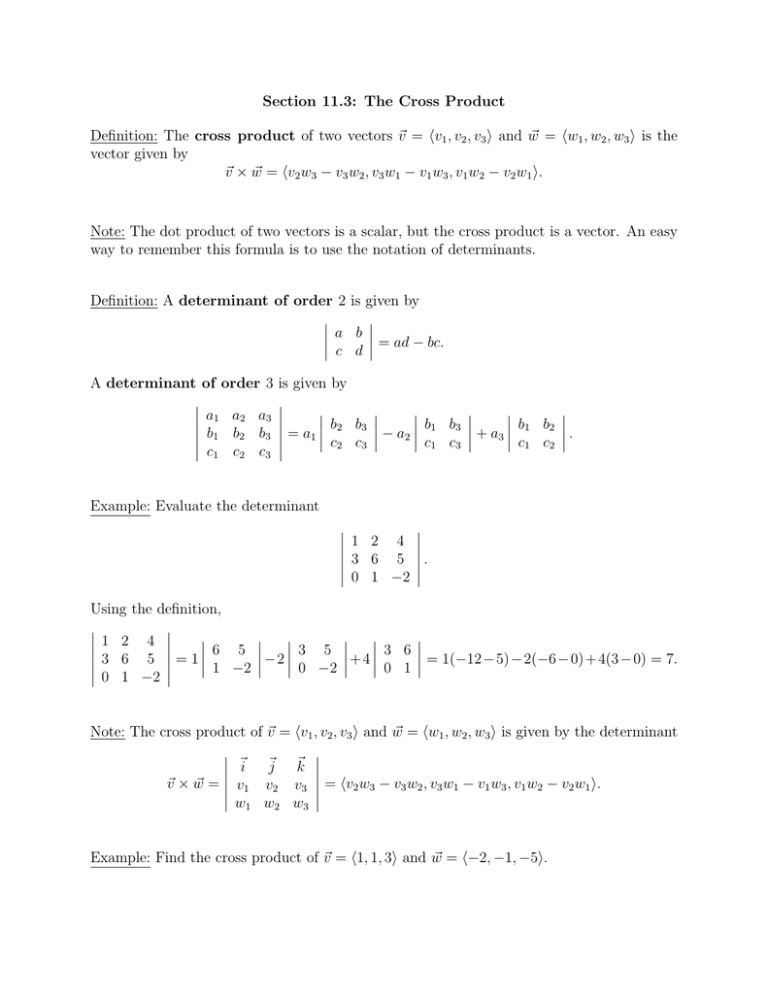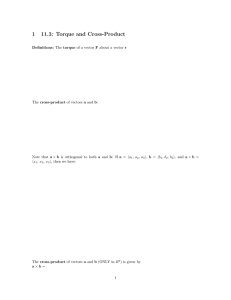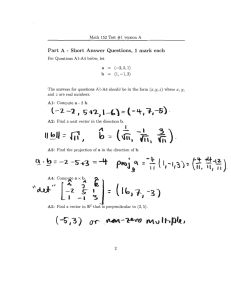Section 11.3: The Cross Product i and ~ i is the
advertisement

Section 11.3: The Cross Product Definition: The cross product of two vectors ~v = hv1 , v2 , v3 i and w ~ = hw1 , w2 , w3 i is the vector given by ~v × w ~ = hv2 w3 − v3 w2 , v3 w1 − v1 w3 , v1 w2 − v2 w1 i. Note: The dot product of two vectors is a scalar, but the cross product is a vector. An easy way to remember this formula is to use the notation of determinants. Definition: A determinant of order 2 is given by a b c d = ad − bc. A determinant of order 3 a1 a2 a3 b1 b2 b3 c1 c2 c3 is given by b1 b2 b1 b3 b2 b3 = a1 c 2 c 3 − a2 c 1 c 3 + a3 c 1 c 2 . Example: Evaluate the determinant Using the definition, 1 2 4 3 6 5 = 1 6 5 1 −2 0 1 −2 −2 3 5 0 −2 1 2 4 3 6 5 0 1 −2 . +4 3 6 0 1 = 1(−12 − 5) − 2(−6 − 0) +4(3 − 0) = 7. Note: The cross product of ~v = hv1 , v2 , v3 i and w ~ = hw1 , w2 , w3 i is given by the determinant ~i ~j ~k ~v × w ~ = v1 v2 v3 = hv2 w3 − v3 w2 , v3 w1 − v1 w3 , v1 w2 − v2 w1 i. w1 w2 w3 Example: Find the cross product of ~v = h1, 1, 3i and w ~ = h−2, −1, −5i. ~v × w ~ = ~k ~i ~j 1 1 3 −2 −1 −5 = h−5 + 3, −6 + 5, −1 + 2i = h−2, −1, 1i. Theorem: (Orthogonality of the Cross Product) If ~v and w ~ are nonzero vectors in R3 that are not scalar multiples of one another, then ~v × w ~ is orthogonal to both ~v and w. ~ ~ is determined by the right-hand rule. Note: The direction of ~v × w 𝑣×𝑤 𝑤 𝑣 Figure 1: The cross product of ~v and w ~ illustrating the right-hand rule. Example: Find a unit vector orthogonal to both ~v = h1, 2, 1i and w ~ = h0, 1, 3i. The cross product is ~v × w ~ = ~i 1 0 ~j 2 1 ~k 1 3 = h6 − 1, 0 − 3, 1 − 0i = h5, −3, 1i. The magnitude of the cross product is ||~v × w|| ~ = √ 25 + 9 + 1 = √ 35. Thus, a unit vector orthogonal to ~v and w ~ is ~v × w ~ 5 3 1 ~u = = √ , −√ , √ . ||~v × w|| ~ 35 35 35 Example: Find a vector orthogonal to the plane passing through the points A = (1, 2, 1), B = (3, 5, 0), and C = (5, 4, −2). The plane contains the vectors −→ AB = h3 − 1, 5 − 2, 0 − 1i = h2, 3, −1i, −→ AC = h5 − 1, 4 − 2, −2 − 1i = h4, 2, −3i. The cross product is orthogonal to the plane ~i ~j ~k −→ −→ AB × AC = 2 3 −1 = h−7, 2, −8i. 4 2 −3 Another vector orthogonal to the plane is −(~v × w) ~ = h7, −2, 8i. Theorem: (Magnitude of the Cross Product) If ~v and w ~ are nonzero vectors in R3 and θ is the angle between ~v and w ~ (0 ≤ θ ≤ π), then ||~v × w|| ~ = ||~v ||||w|| ~ sin θ. Note: The area of the parallelogram defined by ~v and w ~ is given by ||~v × w||. ~ 𝑤 sin 𝜃 = ℎ ℎ 𝑤 ℎ = 𝑤 sin 𝜃 𝜃 𝑣 𝐴𝑟𝑒𝑎 = 𝐵𝑎𝑠𝑒 × Height = 𝑣 𝑤 sin 𝜃 = 𝑣 × 𝑤 Figure 2: Illustration of ||~v × w|| ~ as the area of a parallelogram. Example: Find the area of the parallelogram defined by ~v = h1, 1, −2i and w ~ = h2, −1, −1i. The cross product is ~v × w ~ = ~k ~i ~j 1 1 −2 = h−3, −3, −3i. 2 −1 −1 Then the area of the parallelogram is ||~v × w|| ~ = √ √ 9 + 9 + 9 = 3 3. Definition: If ~u, ~v , and w ~ are nonzero vectors that do not lie in the same plane, then the scalar triple product is given by (~u × ~v ) · w. ~ Theorem: (Volume of a Parallelepiped) The volume of the parallelepiped defined by the vectors ~u, ~v , and w ~ is given by V = |(~u × ~v ) · w|. ~ 𝑤 𝑣 𝑢 Figure 3: Parallelepiped defined by the vectors ~u, ~v , and w. ~ Example: Find the volume of the parallelepiped defined by the vectors ~u = h2, 1, −1i, ~v = h3, 0, 1i, w ~ = h0, 1, 1i. The cross product of ~u and ~v is ~i ~j ~k ~u × ~v = 2 1 −1 = h1, −5, −3i. 3 0 1 The volume of the parallelepiped is V = |(~u × ~v ) · w| ~ = |1(0) − 5(1) − 3(1)| = 8.






